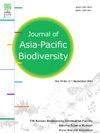揭示济州岛入侵梅花鹿(Cervus nippon)的群体动态和栖息地利用模式:来自相机捕获分析的见解
IF 0.7
Q4 BIODIVERSITY CONSERVATION
引用次数: 0
摘要
入侵物种对当地生态系统和物种构成重大威胁,特别是在地方特有率高和易感性高的岛屿上。梅花鹿(Cervus nippon)被引入韩国,对包括济州岛在内的野生生态系统和本地物种造成了负面影响。然而,人们对梅花鹿生态学的了解有限,无法为有效的物种管理和政策决策提供信息。为了弥补这一知识空白,我们通过分析3年的相机陷阱数据,研究了韩国济州岛梅花鹿的群体动态,重点研究了年龄-性别阶层结构、群体规模和栖息地利用变化。我们的研究结果表明,雌性的性别比例略有倾斜,成年和一岁的幼崽占主导地位。各年龄级的年相对丰度在5月和8月出现高峰,而幼鸟的年相对丰度在8月出现高峰。种群大小为1 ~ 7只,平均为3.72±1.25只。不同年龄层的生境利用模式不同,幼鱼丰度随距离森林边缘的增加而增加,而成年雌鱼则在靠近人类住区的地方活跃。本研究强调了控制成年雌梅花鹿数量作为缓解梅花鹿栖息地利用冲突的直接策略的重要性。通过研究梅花鹿的独特行为和栖息地偏好,我们的研究结果为明智的决策、有效的物种管理和本地生态系统的保护提供了有价值的见解,特别是在济州岛。本文章由计算机程序翻译,如有差异,请以英文原文为准。
Unveiling group dynamics and habitat utilization patterns of invasive sika deer (Cervus nippon) in Jeju Island, South Korea: Insights from camera trapping analysis
Invasive species pose significant threats to native ecosystems and species, especially on islands with high rates of endemism and susceptibility. The introduction of the sika deer (Cervus nippon) to South Korea has negatively impacted its wild ecosystems and native species, including those on Jeju Island. However, there is limited knowledge of sika deer ecology to inform effective species management and policy decisions. To bridge this knowledge gap, we examined the group dynamics, with a focus on age-sex class structure, group size, and habitat utilization variation of sika deer on Jeju Island, South Korea, by analyzing three years of camera trap data. Our findings illuminate a slightly skewed sex ratio toward females, with adults and yearlings comprising the dominant age class. The annual relative abundance of each age class showed a single activity peak in May for both yearlings and adults, whereas a peak was observed in August for juveniles. Group sizes ranged from to 1–7 individuals, with a mean group size of 3.72 ± 1.25 individuals. Habitat utilization patterns differed by age class, with juvenile abundance escalating with increasing distance from the forest edge, whereas adult females were active close to human settlements. This study highlights the critical importance of controlling the adult female population as a direct strategy for mitigating conflicts arising from sika deer habitat utilization. By addressing the unique behavior and habitat preferences of sika deer, our findings provide valuable insights for informed decision-making, effective species management, and preservation of native ecosystems, particularly on Jeju Island.
求助全文
通过发布文献求助,成功后即可免费获取论文全文。
去求助
来源期刊

Journal of Asia-Pacific Biodiversity
Agricultural and Biological Sciences-Insect Science
CiteScore
1.70
自引率
12.50%
发文量
94
审稿时长
27 days
期刊介绍:
The Journal of Asia-Pacific Biodiversity (previous title was Journal of Korean Nature) is an official journal of National Science Museum of Korea (NSMK) and Korea National Arboretum (KNA). The scope of journal is wide and multidisciplinary that publishes original research papers, review articles, as well as conceptual, technical and methodological papers on all aspects of biological diversity-its description, analysis and conservation, and its application by humankind. This wide and multidisciplinary journal aims to provide both scientists and practitioners in conservation theory, policy and management with comprehensive and applicable information. However, papers should not be submitted that deal with microorganisms, except in invited paper. Articles that are focused on the social and economical aspects of biodiversity will be normally not accepted.
 求助内容:
求助内容: 应助结果提醒方式:
应助结果提醒方式:


